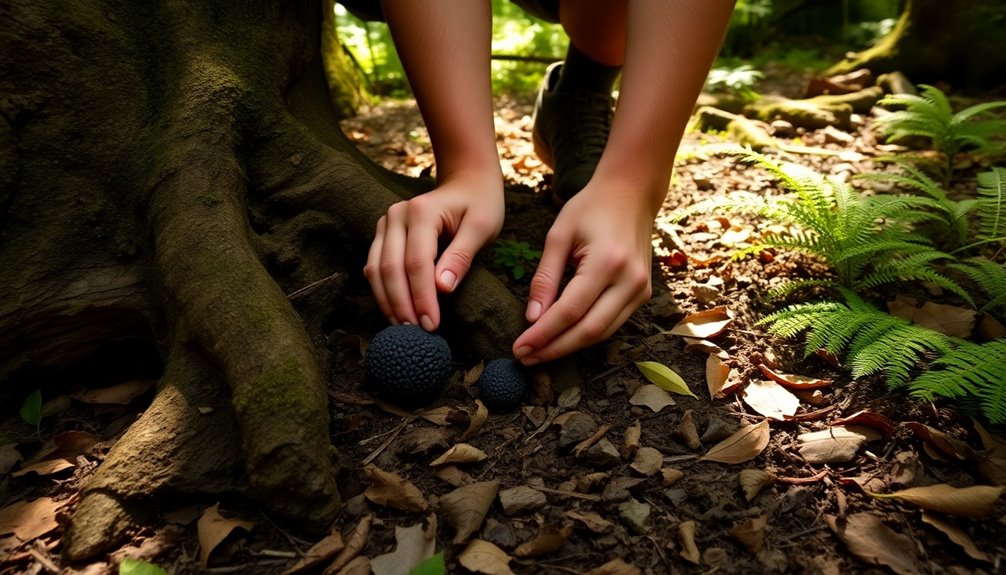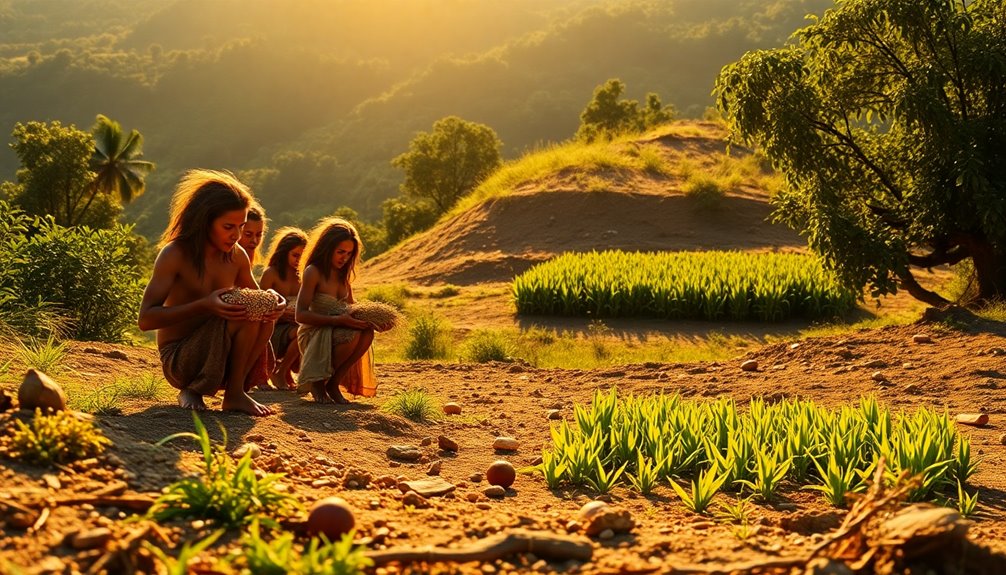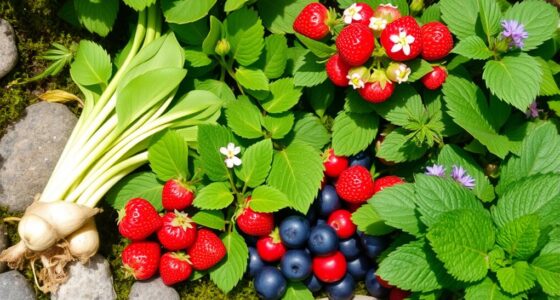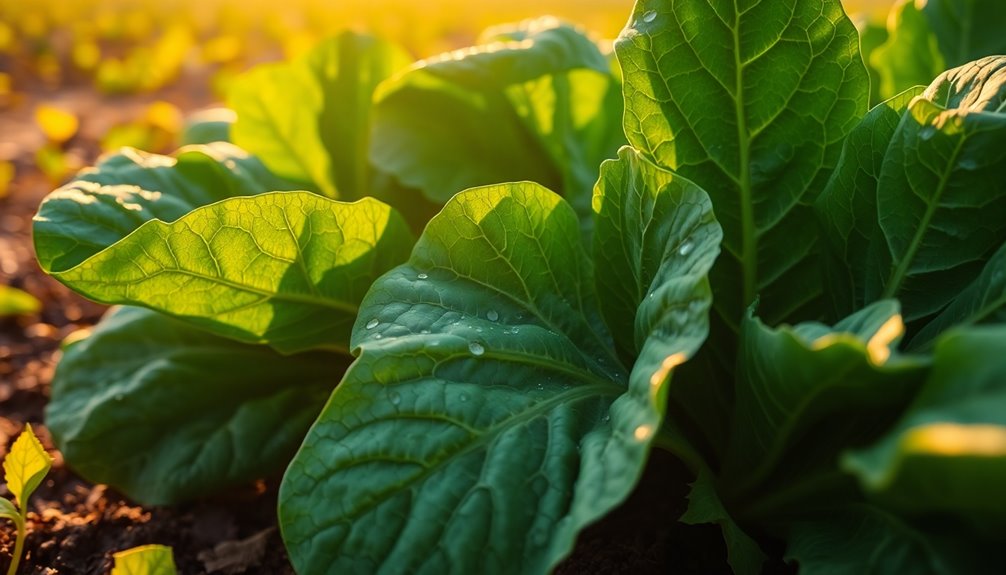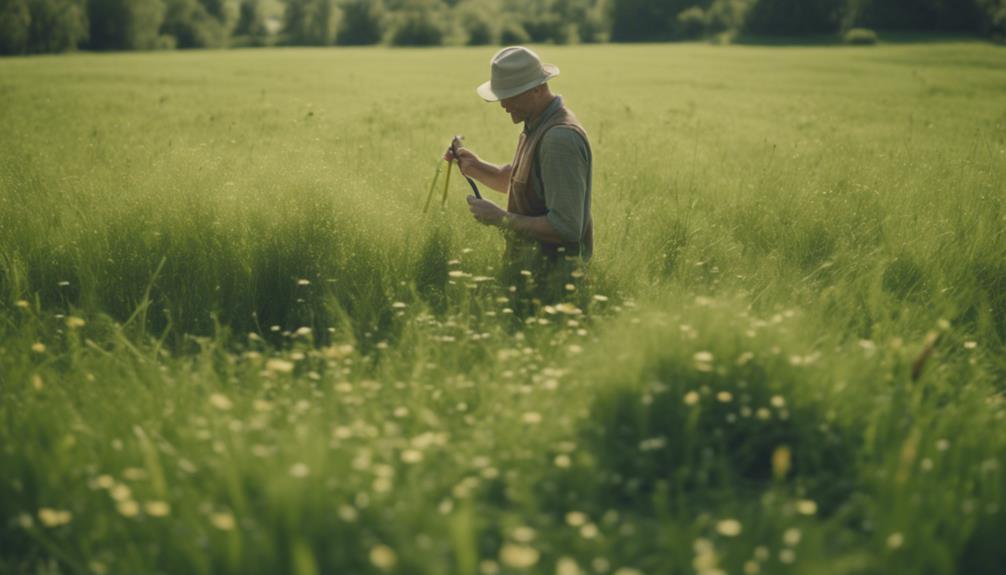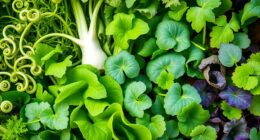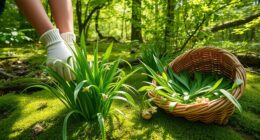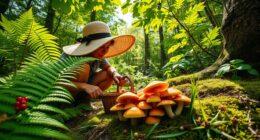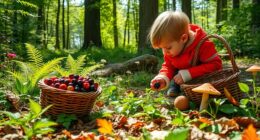If you're looking to forage for truffles, focus on oak and hazelnut trees, which are their favorite hosts. You'll have better luck in regions with warm, damp soil, particularly in forests known for biodiversity. However, be discreet; these locations are closely guarded secrets among chefs and foragers. Participate in local foraging events or connect with experienced hunters to learn more about sustainable practices. Remember, the best spots require patience and respect for the environment. Curious about the best techniques or seasonal tips? There's plenty more to uncover that can enhance your truffle foraging journey.
Key Takeaways
- Truffles thrive under specific trees like oaks and hazelnuts, making these areas prime for foraging.
- Look for warm, damp soil, especially in regions with rich biodiversity, to increase your chances of finding truffles.
- Experienced foragers assess local flora and fauna, using their knowledge of seasonal conditions to identify potential truffle sites.
- Secretive foraging locations are often passed down through generations, with community members protecting these spots from theft.
- Sustainable practices, such as rotating harvesting sites, are crucial for preserving truffle populations and the surrounding ecosystem.
Secrecy in Truffle Locations
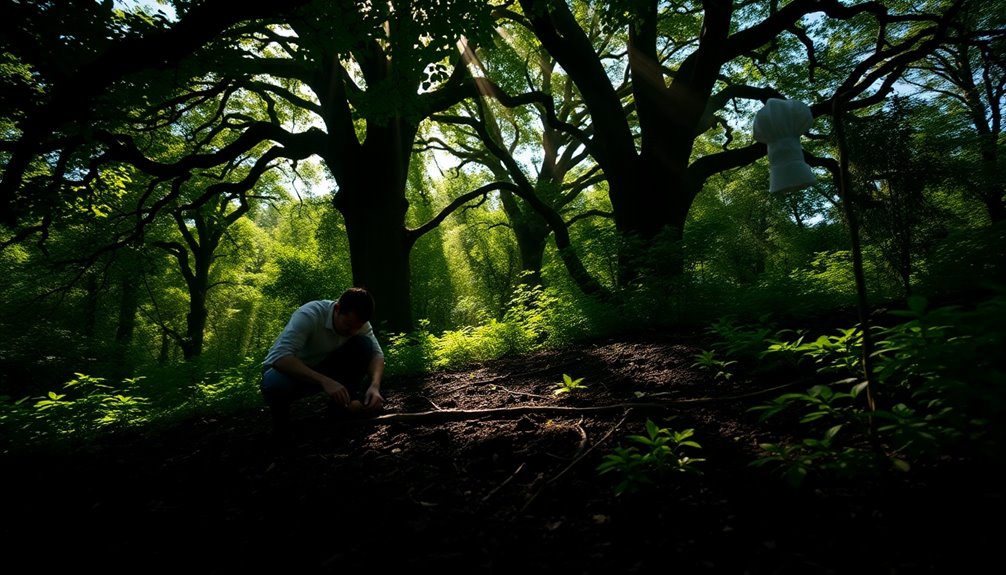
In the world of truffle hunting, secrecy is paramount. As a truffle hunter, you know the value of keeping your truffle patches under wraps. White truffles can fetch staggering prices, making their locations a closely guarded secret. The high financial returns these spots yield over time create a competitive landscape where theft is rampant. To protect your hard-earned finds, you've got to be discreet.
Experienced hunters like you identify potential truffle sites by carefully observing soil conditions and surrounding plant life, which can signal the presence of truffles. But even mentioning specific locations can spark disputes and mistrust among fellow hunters. You often find yourself using unmarked transportation to further conceal your routes, ensuring your valuable harvest remains safe from prying eyes.
The practice of secrecy isn't just a choice; it's a necessity. Whether you're foraging for white truffles or planning to create exquisite truffle oil, maintaining confidentiality about your locations is vital.
In this game, sharing too much can lead to losing not only your finds but also your standing within the truffle hunting community. Stay vigilant, and keep your secrets close.
Ideal Tree Species for Truffles
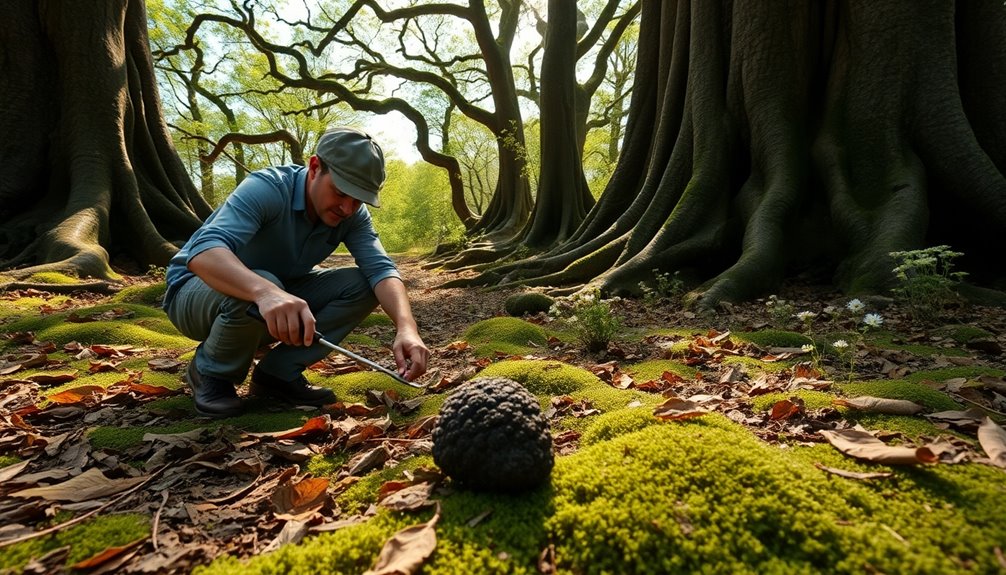
When selecting tree species for truffle cultivation, you'll often find that certain types are more compatible with truffle fungi than others. The right tree can make all the difference in your truffle-hunting journey.
Here are four ideal tree species to evaluate:
- Oak Trees (Quercus robur and Quercus ilex): These immature oak trees form a symbiotic relationship with truffle fungi, making them excellent hosts.
- Hazelnut Trees (Corylus avellana): Particularly favorable for black truffles (Tuber melanosporum), hazelnut trees are a popular choice for truffle farming.
- Douglas Fir Trees (Pseudotsuga menziesii): In the Pacific Northwest, these trees are essential for native black truffles, showcasing the importance of regional compatibility.
- Other Nut Trees: While not as prominent, some nut trees can also support truffle growth, offering additional options for your truffle garden.
Keep in mind that truffle cultivation can be a waiting game. It may take 7 to 10 years to see results, and the success rate is about 25%.
Techniques for Successful Foraging
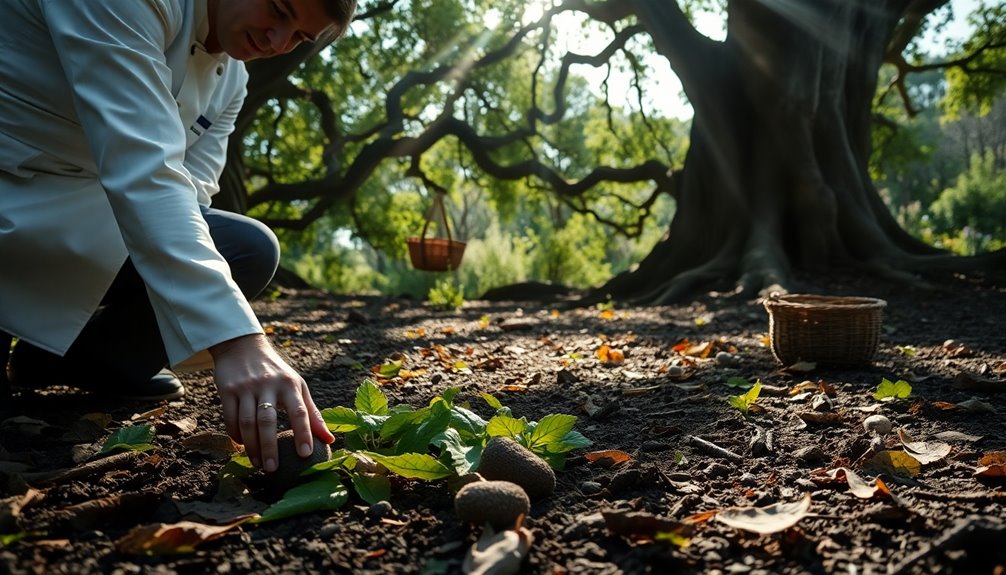
When you're out foraging for truffles, understanding seasonal factors is key to your success.
Training your dog effectively can make a huge difference, as a well-prepared pup will help you locate those hidden treasures.
Plus, adopting sustainable harvesting practices guarantees that truffle populations remain healthy for future hunts.
Seasonal Foraging Factors
Successful truffle foraging hinges on understanding seasonal factors that impact growth and availability. Knowing when and where to search can make all the difference. Here are some key points to take into account:
- Weather Patterns: Monitor seasonal conditions; warm, moist weather is essential for truffle development.
- Soil Conditions: Keep an eye on soil moisture and temperature. Truffles thrive in warm, damp soil, particularly in the presence of host trees like oaks and apple trees.
- Ecosystem Health: A strong ecosystem supports wild mushrooms and truffles. Ascertain areas have healthy flora and fauna to boost your foraging success.
- Species Seasonality: Different truffle species, like summer and winter truffles, have unique growth cycles. Adapt your foraging strategies based on which species is in season.
- Understanding the importance of ecosystem health can significantly enhance your chances of finding truffles, as a rich biodiversity supports their growth.
Dog Training Techniques
To effectively train your dog for truffle foraging, you need to create a strong association between the scent of truffles and positive rewards. Start by using truffle oil-infused cotton balls during your training sessions. Let your dog sniff the cotton balls and reward them immediately with treats or praise when they show interest. This builds a positive connection to the scent.
Incorporate scent detection exercises to enhance their skills. Hide the cotton balls in various locations and encourage your dog to find them.
Make sure to monitor your trained dog closely during actual foraging. You don't want them to consume the truffles they locate, as this could ruin your harvest.
Remember that seasonal conditions and site health can influence your dog's ability to find truffles. Adjust your training and foraging strategies throughout the year to keep them effective.
Keep the training process enjoyable for your dog; it's essential for maintaining their enthusiasm and focus. By using these techniques, you'll enhance your dog's hunting skills and improve your chances of a successful truffle foraging adventure.
Happy hunting!
Sustainable Harvesting Practices
Sustainable harvesting practices are vital for preserving truffle populations and their ecosystems. When you're foraging for truffles, it's important to adopt methods that guarantee these delicacies can thrive for generations to come.
Here are some techniques to keep in mind:
- Rotate Your Locations: Move around different truffle hunting spots to give ecosystems time to recover, ensuring future harvests remain abundant.
- Watch Your Dog: Keep an eye on your trained dog to prevent them from eating the truffles they find. This preserves your harvest for culinary use.
- Keep Locations Secret: Maintain the confidentiality of your truffle sites to minimize the risk of theft and over-harvesting, protecting the integrity of the ecosystem.
- Respect the Environment: Be mindful of the forest floor and surrounding vegetation during the extraction process. Avoid damaging the habitat to maintain a healthy ecosystem.
Seasonal Considerations for Hunting
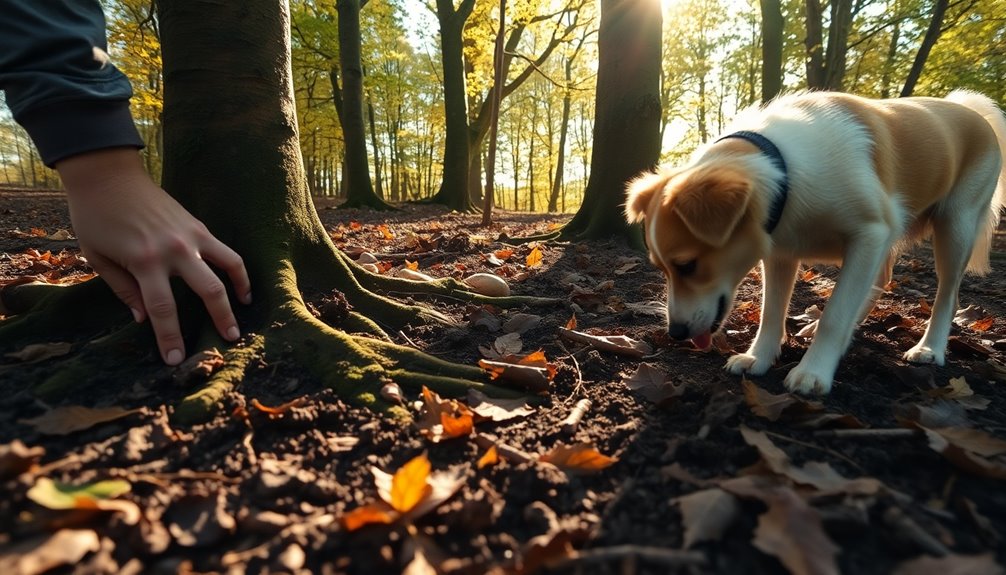
Timing is essential when hunting for truffles, as the late fall and winter months provide the best opportunities for foragers. Specifically, if you're targeting winter truffles (Tuber melanosporum), aim for the November to March window.
During this period, the seasonal weather patterns are critical; adequate rainfall in the months leading up to winter promotes healthy truffle growth and enhances their flavor.
When foraging, focus on well-drained, calcareous soils typically found under oak, hazelnut, or beech trees. These specific conditions are indispensable for truffle development.
Additionally, seasonal fluctuations can affect the aroma and flavor profile of truffles, making early winter finds often more prized.
As you hunt, keep an eye on the life cycle of truffle trees; understanding their growth patterns throughout the seasons can greatly boost your chances of success.
Culinary Uses of Foraged Truffles
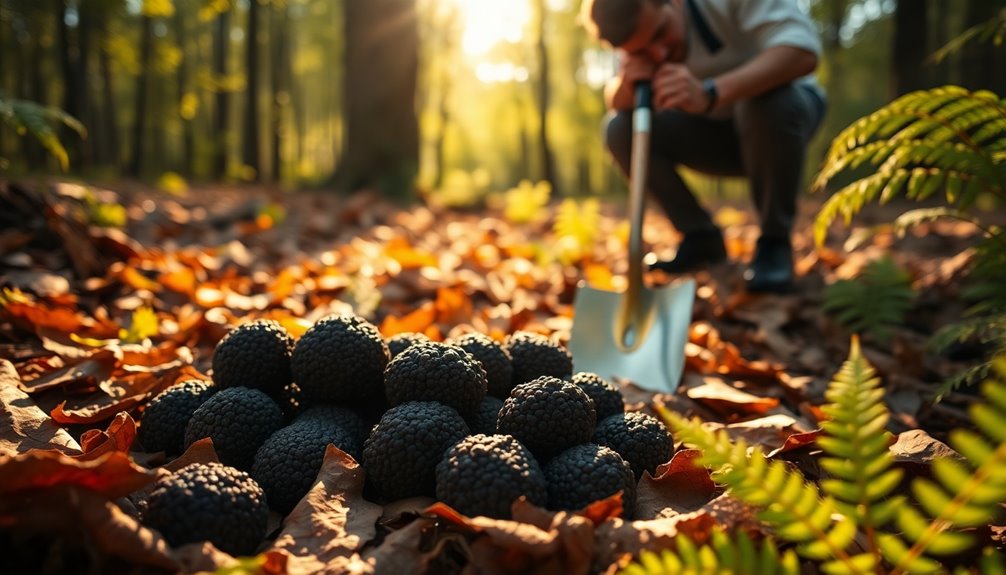
When you incorporate foraged truffles into your cooking, you can greatly enhance the flavor of your dishes.
By using various infusion methods, you'll create rich, aromatic experiences that transform everything from pasta to sauces.
Plus, with the right culinary pairings, you can elevate your meals to new heights, celebrating the unique taste of truffles in every bite.
Flavor Enhancement Techniques
Foraging for truffles opens up a world of flavor enhancement techniques that can transform your culinary creations. Their strong, earthy aroma elevates an array of dishes, particularly creamy ones like pasta and sauces. Truffles pair exceptionally well with rich ingredients like cheesy polenta, enhancing their flavor profile. Additionally, the unique aroma of truffles can create a sensory experience similar to the coffee culture found in artisanal cafés. Understanding investment strategies can help you appreciate the value of these gourmet ingredients as they enhance your culinary skills. Furthermore, truffles can be used to create compound butter, allowing for a rich and flavorful addition to your cooking.
Here are four ways you can use foraged truffles to enhance your meals:
- Shaved Over Dishes: Shave fresh truffles directly onto your pasta or risotto just before serving to infuse an intense aroma and flavor.
- Truffle Butter: Blend softened butter with finely grated truffles, allowing the flavors to meld. Use this luxurious spread on bread or as a finishing touch on vegetables.
- Truffle-Infused Cheese: Place truffles next to your favorite cheese in the fridge for several days. The cheese will absorb the truffle's essence, creating a gourmet treat.
- Soup and Sauce Enhancer: Incorporate finely chopped or shaved truffles into your soups and sauces. Their unique flavor profile adds depth and sophistication, making any dish feel special.
Additionally, the use of truffles can complement other Southern comfort foods, such as fried catfish, by creating a luxurious twist on traditional dishes.
Infusion Methods Explained
Infusing truffles into various culinary delights can elevate your dishes with their rich, earthy flavor. One popular method is to incorporate truffles into fats like butter or cheese. By refrigerating these mixtures for a few days, you allow the truffle's unique essence to permeate, creating a luxurious ingredient that enhances everything from bread to meats.
You can also create infused oils by placing fresh truffles next to fatty foods. This process results in a flavorful oil perfect for drizzling over salads or pasta, adding a gourmet touch to simple meals.
Truffle-infused cheeses provide another fantastic option, marrying the creamy richness of cheese with the distinctive aroma of truffles for a truly unique tasting experience.
For an easy yet elegant addition to your kitchen, try making truffle butter. It's a simple way to elevate the taste of your favorite dishes. However, be cautious during the infusion process to avoid contamination with living organisms. This guarantees that the truffle flavor remains intact and safe for consumption.
With these infusion methods, you can bring the essence of truffles into your cooking and impress your guests with every bite.
Culinary Pairing Suggestions
Enhancing your culinary creations with truffles opens up a world of flavor combinations that can transform even the simplest dishes.
These aromatic fungi offer unique pairings that elevate your meals, making them unforgettable. Here are some culinary pairing suggestions to explore:
- Pasta Dishes: Incorporate shaved truffles into creamy pasta, where the al dente texture mingles beautifully with rich egg mixtures and pancetta, creating savory depth.
- Soups and Spreads: Add shaved truffles to a creamy tomato soup or blend them into truffle-infused butter to spread on crusty bread, enhancing both flavor and presentation.
- Risottos and Meats: Use truffle oil or butter in your risottos or drizzled over grilled meats, infusing them with luxurious depth and an earthy aroma.
- Cheese and Wine: Experiment with truffle-infused cheeses, pairing them with your favorite wines or topping gourmet pizzas for a unique tasting experience.
Additionally, consider serving truffles with savory appetizers like crab cakes or queso fundido to create a decadent start to your meal.
With truffles' seasonal availability, don't miss out on special menu items at local restaurants that showcase these gourmet delights.
Embrace the opportunity to indulge in these exquisite flavors!
Community and Sustainability in Truffle Harvesting
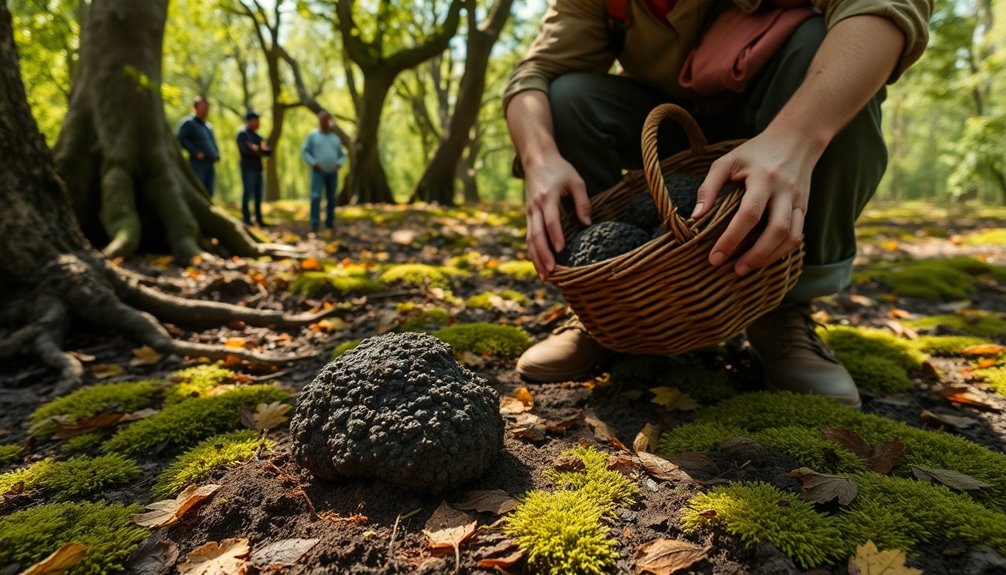
Sustainability is at the heart of responsible truffle harvesting, guaranteeing that these prized fungi can thrive for generations to come. When you forage for truffles, adopting sustainable harvesting practices is vital. This approach not only prevents ecosystem damage but also assures the long-term viability of truffle populations.
By rotating your harvesting locations, you allow the forest floor to recover and maintain the health of truffle-producing areas. Organizations like the Truffle Dog Company stress the importance of educating foragers on responsible techniques. It's essential to monitor your dogs to prevent them from eating the finds, preserving the truffles for culinary use.
Community initiatives, such as tree adoption programs, further enrich local economies and support charitable causes, like the One Family orphanage in Haiti. Keep in mind that seasonal conditions and site health greatly influence your truffle foraging success.
Being aware of these factors and adapting your methods accordingly will enhance your experience and contribute positively to the ecosystem. By prioritizing sustainability and community involvement, you not only enjoy the thrill of the hunt but also help secure that truffles remain a treasured delicacy for the future.
Frequently Asked Questions
Where in the US Can You Find Truffles?
You can find truffles in various regions across the U.S. Start exploring the Pacific Northwest, especially under Douglas fir trees, where native black truffles thrive.
Northern California, particularly Mendocino County, offers ideal conditions for truffle cultivation.
Don't overlook the Southeast, with emerging farms in North Carolina and Georgia producing Tuber melanosporum.
How Do You Know Where to Dig for Truffles?
Finding truffles is like hunting for hidden treasure in a forest. To know where to dig, look for specific signs.
Check the soil conditions—truffles prefer well-drained, calcareous soils with a slightly alkaline pH. Observe nearby trees like oaks and hazelnuts, as they often indicate truffle presence.
Keep an eye out for truffle flies hovering near potential spots, and remember to monitor seasonal changes that could affect truffle growth.
Happy digging!
Where Are the Best Places to Find Truffles?
If you're looking for the best places to find truffles, focus on regions with specific soil conditions. Areas like the Mediterranean, California, and the Pacific Northwest are ideal.
Look for forests with oak, hazelnut, or beech trees as hosts. You'll also want to explore renowned spots in France, Italy, and Croatia.
Where Can I Collect Truffles?
You won't believe the treasure hunt that awaits you! To collect truffles, head to forests filled with oak, hazelnut, or beech trees—they're like nature's secret vaults.
In the Pacific Northwest, look for Douglas firs, where black truffles hide. The cooler months are your best bet, so gear up for an adventure!
Just remember, knowledge is key; check soil conditions and rotate your spots to keep the truffle magic alive!
Conclusion
So, next time you're wandering through a forest, remember that truffles might be hiding beneath your feet. While the secret spots chefs won't share can be elusive, you can uncover them with the right tree knowledge and techniques. Plus, it's a fun adventure that connects you to nature. Who knows, you might even stumble upon a treasure! Just keep the locations to yourself—after all, sharing may lead to overharvesting, and we don't want to spoil the magic.

